Strategic Leadership: Analyzing Change in Organizations Report
VerifiedAdded on 2022/12/29
|20
|6361
|96
Report
AI Summary
This report delves into the complexities of organizational change and leadership, examining the impact of change on organizations like Marks & Spencer, Tesco, and Nokia. It explores internal and external drivers of change, such as technology, competition, and customer preferences, and analyzes their effects on organizational operations, strategy, and individual behaviors. The report evaluates various leadership approaches and models, including force field analysis, to assess organizational responses to change, offering conclusions and recommendations for effective change management. It covers the impact of change drivers on individual behavior, leadership, and team dynamics, as well as barriers to change and leadership decision-making. The report emphasizes the importance of adapting to change and provides insights into different leadership styles and approaches for dealing with change across various organizational contexts. It assesses the effectiveness of leadership approaches and models of change management, culminating in a critical evaluation and recommendations for strategic leadership in a dynamic business environment.
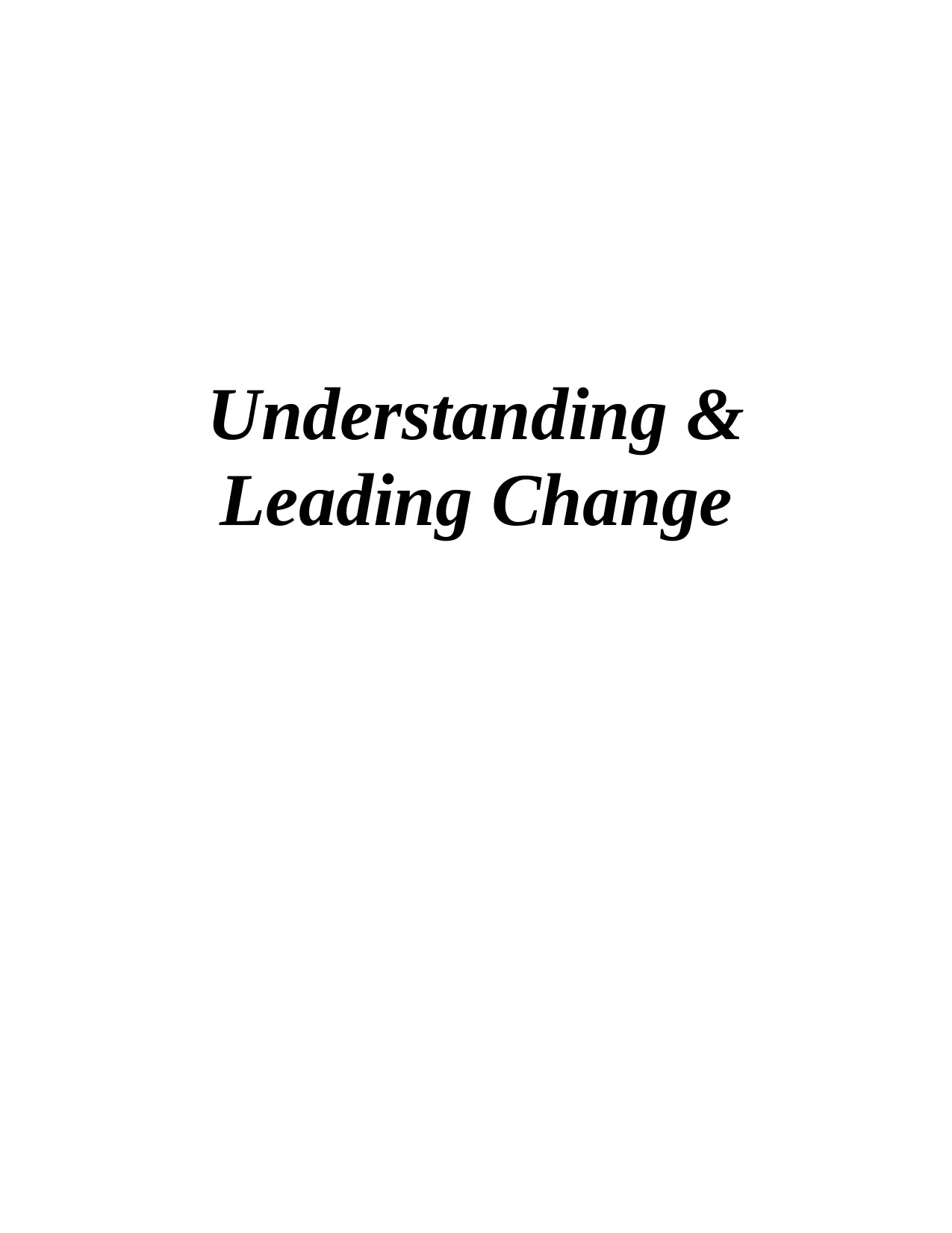
Understanding &
Leading Change
Leading Change
Paraphrase This Document
Need a fresh take? Get an instant paraphrase of this document with our AI Paraphraser
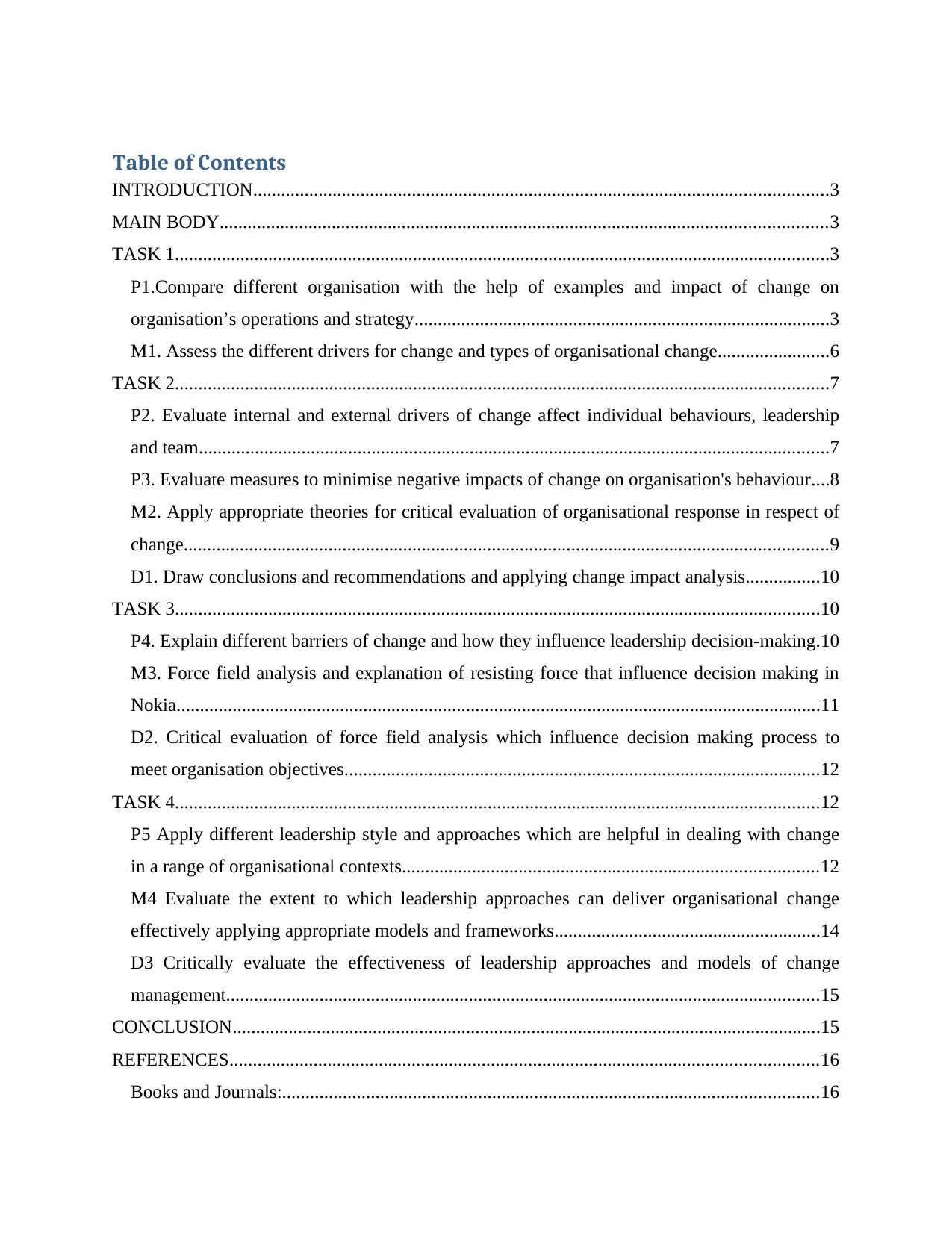
Table of Contents
INTRODUCTION...........................................................................................................................3
MAIN BODY..................................................................................................................................3
TASK 1............................................................................................................................................3
P1.Compare different organisation with the help of examples and impact of change on
organisation’s operations and strategy.........................................................................................3
M1. Assess the different drivers for change and types of organisational change........................6
TASK 2............................................................................................................................................7
P2. Evaluate internal and external drivers of change affect individual behaviours, leadership
and team.......................................................................................................................................7
P3. Evaluate measures to minimise negative impacts of change on organisation's behaviour....8
M2. Apply appropriate theories for critical evaluation of organisational response in respect of
change..........................................................................................................................................9
D1. Draw conclusions and recommendations and applying change impact analysis................10
TASK 3..........................................................................................................................................10
P4. Explain different barriers of change and how they influence leadership decision-making.10
M3. Force field analysis and explanation of resisting force that influence decision making in
Nokia..........................................................................................................................................11
D2. Critical evaluation of force field analysis which influence decision making process to
meet organisation objectives......................................................................................................12
TASK 4..........................................................................................................................................12
P5 Apply different leadership style and approaches which are helpful in dealing with change
in a range of organisational contexts.........................................................................................12
M4 Evaluate the extent to which leadership approaches can deliver organisational change
effectively applying appropriate models and frameworks.........................................................14
D3 Critically evaluate the effectiveness of leadership approaches and models of change
management...............................................................................................................................15
CONCLUSION..............................................................................................................................15
REFERENCES..............................................................................................................................16
Books and Journals:...................................................................................................................16
INTRODUCTION...........................................................................................................................3
MAIN BODY..................................................................................................................................3
TASK 1............................................................................................................................................3
P1.Compare different organisation with the help of examples and impact of change on
organisation’s operations and strategy.........................................................................................3
M1. Assess the different drivers for change and types of organisational change........................6
TASK 2............................................................................................................................................7
P2. Evaluate internal and external drivers of change affect individual behaviours, leadership
and team.......................................................................................................................................7
P3. Evaluate measures to minimise negative impacts of change on organisation's behaviour....8
M2. Apply appropriate theories for critical evaluation of organisational response in respect of
change..........................................................................................................................................9
D1. Draw conclusions and recommendations and applying change impact analysis................10
TASK 3..........................................................................................................................................10
P4. Explain different barriers of change and how they influence leadership decision-making.10
M3. Force field analysis and explanation of resisting force that influence decision making in
Nokia..........................................................................................................................................11
D2. Critical evaluation of force field analysis which influence decision making process to
meet organisation objectives......................................................................................................12
TASK 4..........................................................................................................................................12
P5 Apply different leadership style and approaches which are helpful in dealing with change
in a range of organisational contexts.........................................................................................12
M4 Evaluate the extent to which leadership approaches can deliver organisational change
effectively applying appropriate models and frameworks.........................................................14
D3 Critically evaluate the effectiveness of leadership approaches and models of change
management...............................................................................................................................15
CONCLUSION..............................................................................................................................15
REFERENCES..............................................................................................................................16
Books and Journals:...................................................................................................................16
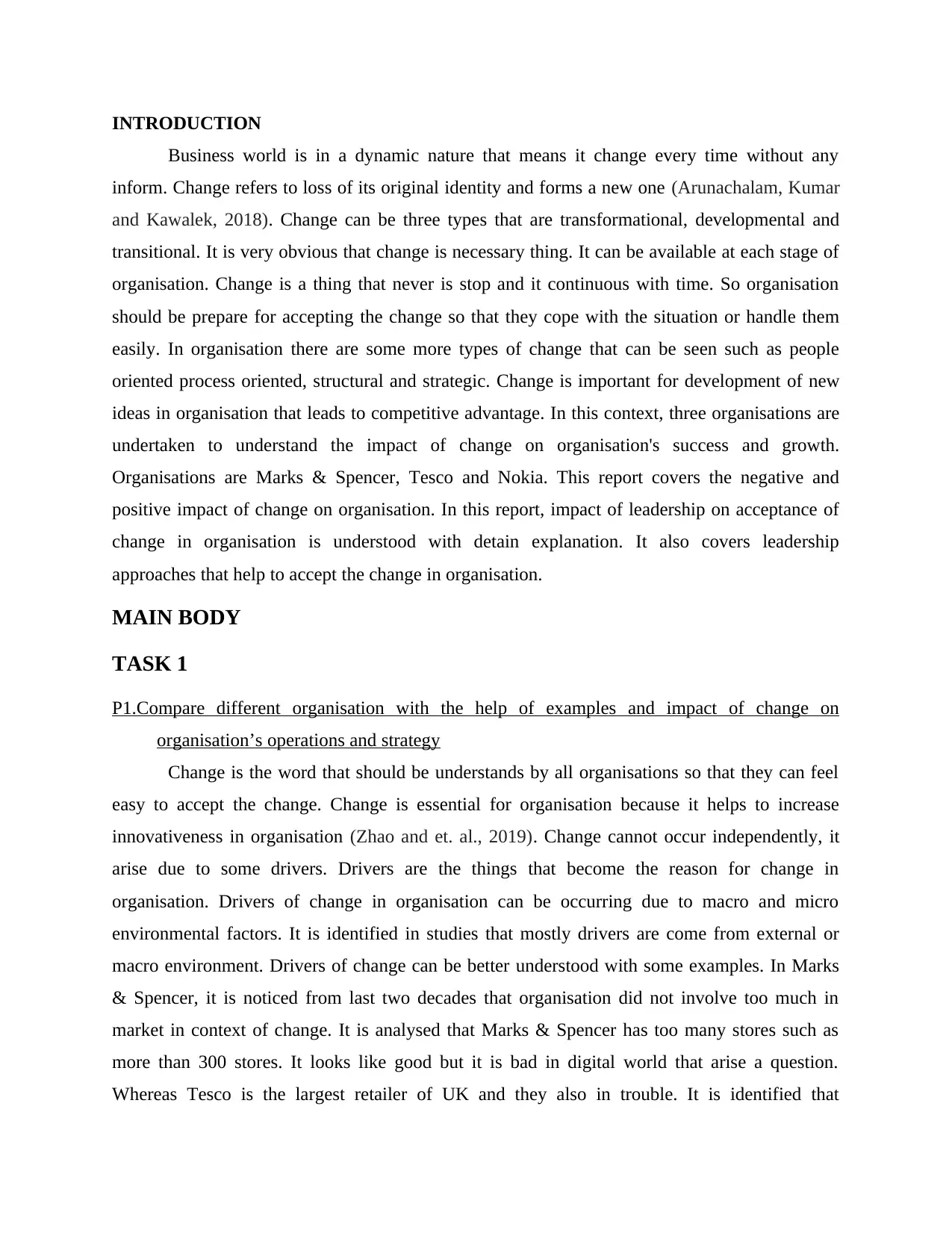
INTRODUCTION
Business world is in a dynamic nature that means it change every time without any
inform. Change refers to loss of its original identity and forms a new one (Arunachalam, Kumar
and Kawalek, 2018). Change can be three types that are transformational, developmental and
transitional. It is very obvious that change is necessary thing. It can be available at each stage of
organisation. Change is a thing that never is stop and it continuous with time. So organisation
should be prepare for accepting the change so that they cope with the situation or handle them
easily. In organisation there are some more types of change that can be seen such as people
oriented process oriented, structural and strategic. Change is important for development of new
ideas in organisation that leads to competitive advantage. In this context, three organisations are
undertaken to understand the impact of change on organisation's success and growth.
Organisations are Marks & Spencer, Tesco and Nokia. This report covers the negative and
positive impact of change on organisation. In this report, impact of leadership on acceptance of
change in organisation is understood with detain explanation. It also covers leadership
approaches that help to accept the change in organisation.
MAIN BODY
TASK 1
P1.Compare different organisation with the help of examples and impact of change on
organisation’s operations and strategy
Change is the word that should be understands by all organisations so that they can feel
easy to accept the change. Change is essential for organisation because it helps to increase
innovativeness in organisation (Zhao and et. al., 2019). Change cannot occur independently, it
arise due to some drivers. Drivers are the things that become the reason for change in
organisation. Drivers of change in organisation can be occurring due to macro and micro
environmental factors. It is identified in studies that mostly drivers are come from external or
macro environment. Drivers of change can be better understood with some examples. In Marks
& Spencer, it is noticed from last two decades that organisation did not involve too much in
market in context of change. It is analysed that Marks & Spencer has too many stores such as
more than 300 stores. It looks like good but it is bad in digital world that arise a question.
Whereas Tesco is the largest retailer of UK and they also in trouble. It is identified that
Business world is in a dynamic nature that means it change every time without any
inform. Change refers to loss of its original identity and forms a new one (Arunachalam, Kumar
and Kawalek, 2018). Change can be three types that are transformational, developmental and
transitional. It is very obvious that change is necessary thing. It can be available at each stage of
organisation. Change is a thing that never is stop and it continuous with time. So organisation
should be prepare for accepting the change so that they cope with the situation or handle them
easily. In organisation there are some more types of change that can be seen such as people
oriented process oriented, structural and strategic. Change is important for development of new
ideas in organisation that leads to competitive advantage. In this context, three organisations are
undertaken to understand the impact of change on organisation's success and growth.
Organisations are Marks & Spencer, Tesco and Nokia. This report covers the negative and
positive impact of change on organisation. In this report, impact of leadership on acceptance of
change in organisation is understood with detain explanation. It also covers leadership
approaches that help to accept the change in organisation.
MAIN BODY
TASK 1
P1.Compare different organisation with the help of examples and impact of change on
organisation’s operations and strategy
Change is the word that should be understands by all organisations so that they can feel
easy to accept the change. Change is essential for organisation because it helps to increase
innovativeness in organisation (Zhao and et. al., 2019). Change cannot occur independently, it
arise due to some drivers. Drivers are the things that become the reason for change in
organisation. Drivers of change in organisation can be occurring due to macro and micro
environmental factors. It is identified in studies that mostly drivers are come from external or
macro environment. Drivers of change can be better understood with some examples. In Marks
& Spencer, it is noticed from last two decades that organisation did not involve too much in
market in context of change. It is analysed that Marks & Spencer has too many stores such as
more than 300 stores. It looks like good but it is bad in digital world that arise a question.
Whereas Tesco is the largest retailer of UK and they also in trouble. It is identified that
⊘ This is a preview!⊘
Do you want full access?
Subscribe today to unlock all pages.

Trusted by 1+ million students worldwide
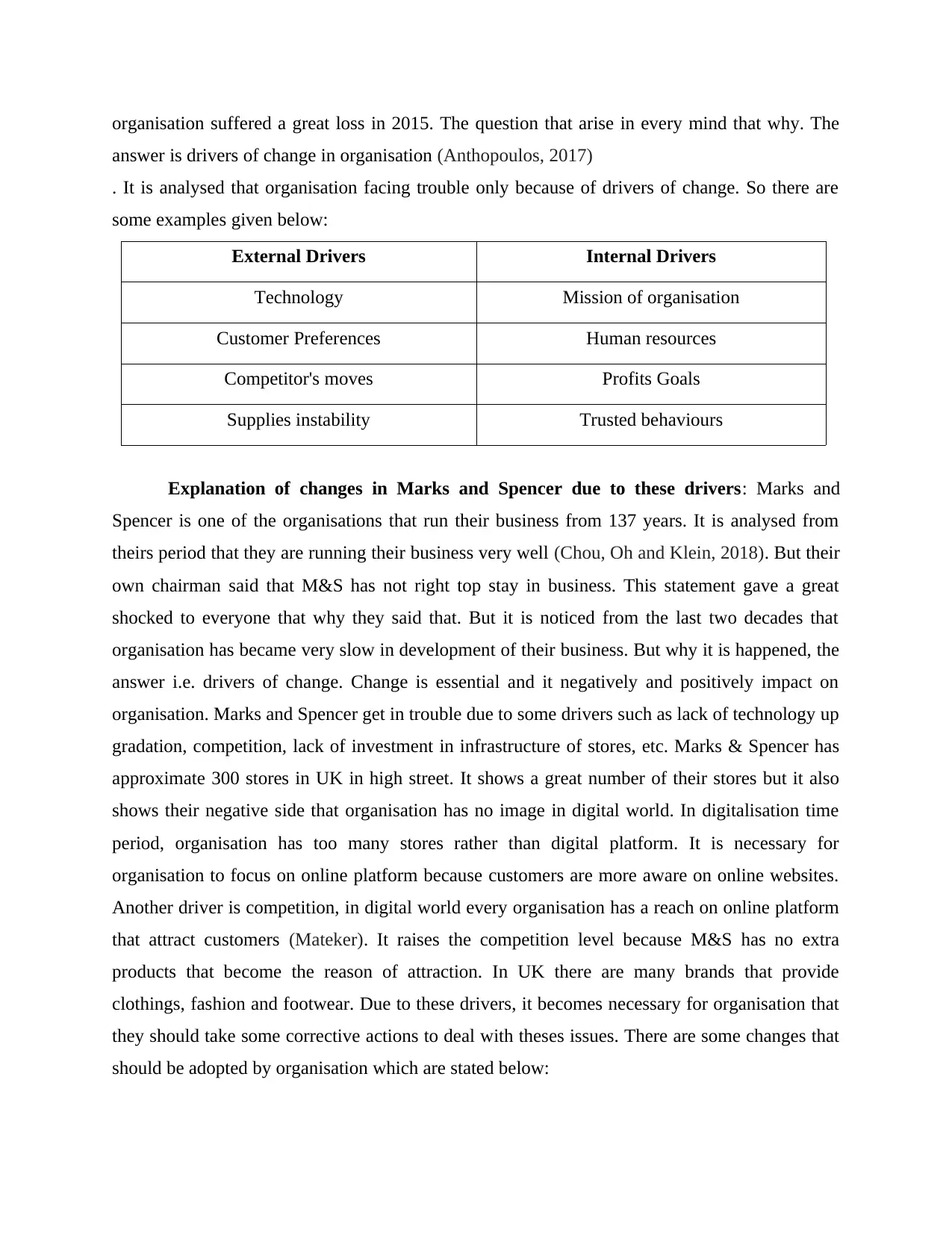
organisation suffered a great loss in 2015. The question that arise in every mind that why. The
answer is drivers of change in organisation (Anthopoulos, 2017)
. It is analysed that organisation facing trouble only because of drivers of change. So there are
some examples given below:
External Drivers Internal Drivers
Technology Mission of organisation
Customer Preferences Human resources
Competitor's moves Profits Goals
Supplies instability Trusted behaviours
Explanation of changes in Marks and Spencer due to these drivers: Marks and
Spencer is one of the organisations that run their business from 137 years. It is analysed from
theirs period that they are running their business very well (Chou, Oh and Klein, 2018). But their
own chairman said that M&S has not right top stay in business. This statement gave a great
shocked to everyone that why they said that. But it is noticed from the last two decades that
organisation has became very slow in development of their business. But why it is happened, the
answer i.e. drivers of change. Change is essential and it negatively and positively impact on
organisation. Marks and Spencer get in trouble due to some drivers such as lack of technology up
gradation, competition, lack of investment in infrastructure of stores, etc. Marks & Spencer has
approximate 300 stores in UK in high street. It shows a great number of their stores but it also
shows their negative side that organisation has no image in digital world. In digitalisation time
period, organisation has too many stores rather than digital platform. It is necessary for
organisation to focus on online platform because customers are more aware on online websites.
Another driver is competition, in digital world every organisation has a reach on online platform
that attract customers (Mateker). It raises the competition level because M&S has no extra
products that become the reason of attraction. In UK there are many brands that provide
clothings, fashion and footwear. Due to these drivers, it becomes necessary for organisation that
they should take some corrective actions to deal with theses issues. There are some changes that
should be adopted by organisation which are stated below:
answer is drivers of change in organisation (Anthopoulos, 2017)
. It is analysed that organisation facing trouble only because of drivers of change. So there are
some examples given below:
External Drivers Internal Drivers
Technology Mission of organisation
Customer Preferences Human resources
Competitor's moves Profits Goals
Supplies instability Trusted behaviours
Explanation of changes in Marks and Spencer due to these drivers: Marks and
Spencer is one of the organisations that run their business from 137 years. It is analysed from
theirs period that they are running their business very well (Chou, Oh and Klein, 2018). But their
own chairman said that M&S has not right top stay in business. This statement gave a great
shocked to everyone that why they said that. But it is noticed from the last two decades that
organisation has became very slow in development of their business. But why it is happened, the
answer i.e. drivers of change. Change is essential and it negatively and positively impact on
organisation. Marks and Spencer get in trouble due to some drivers such as lack of technology up
gradation, competition, lack of investment in infrastructure of stores, etc. Marks & Spencer has
approximate 300 stores in UK in high street. It shows a great number of their stores but it also
shows their negative side that organisation has no image in digital world. In digitalisation time
period, organisation has too many stores rather than digital platform. It is necessary for
organisation to focus on online platform because customers are more aware on online websites.
Another driver is competition, in digital world every organisation has a reach on online platform
that attract customers (Mateker). It raises the competition level because M&S has no extra
products that become the reason of attraction. In UK there are many brands that provide
clothings, fashion and footwear. Due to these drivers, it becomes necessary for organisation that
they should take some corrective actions to deal with theses issues. There are some changes that
should be adopted by organisation which are stated below:
Paraphrase This Document
Need a fresh take? Get an instant paraphrase of this document with our AI Paraphraser
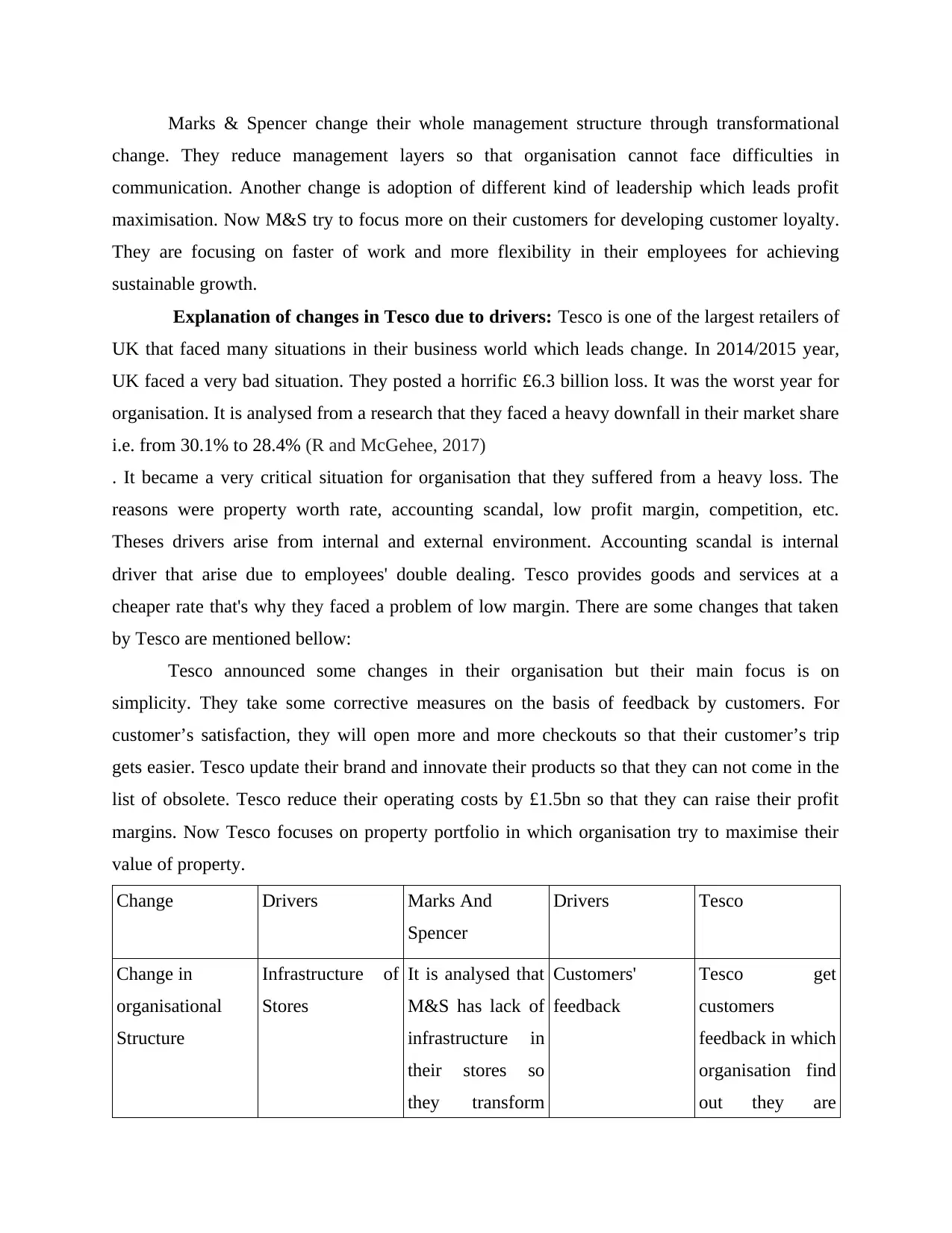
Marks & Spencer change their whole management structure through transformational
change. They reduce management layers so that organisation cannot face difficulties in
communication. Another change is adoption of different kind of leadership which leads profit
maximisation. Now M&S try to focus more on their customers for developing customer loyalty.
They are focusing on faster of work and more flexibility in their employees for achieving
sustainable growth.
Explanation of changes in Tesco due to drivers: Tesco is one of the largest retailers of
UK that faced many situations in their business world which leads change. In 2014/2015 year,
UK faced a very bad situation. They posted a horrific £6.3 billion loss. It was the worst year for
organisation. It is analysed from a research that they faced a heavy downfall in their market share
i.e. from 30.1% to 28.4% (R and McGehee, 2017)
. It became a very critical situation for organisation that they suffered from a heavy loss. The
reasons were property worth rate, accounting scandal, low profit margin, competition, etc.
Theses drivers arise from internal and external environment. Accounting scandal is internal
driver that arise due to employees' double dealing. Tesco provides goods and services at a
cheaper rate that's why they faced a problem of low margin. There are some changes that taken
by Tesco are mentioned bellow:
Tesco announced some changes in their organisation but their main focus is on
simplicity. They take some corrective measures on the basis of feedback by customers. For
customer’s satisfaction, they will open more and more checkouts so that their customer’s trip
gets easier. Tesco update their brand and innovate their products so that they can not come in the
list of obsolete. Tesco reduce their operating costs by £1.5bn so that they can raise their profit
margins. Now Tesco focuses on property portfolio in which organisation try to maximise their
value of property.
Change Drivers Marks And
Spencer
Drivers Tesco
Change in
organisational
Structure
Infrastructure of
Stores
It is analysed that
M&S has lack of
infrastructure in
their stores so
they transform
Customers'
feedback
Tesco get
customers
feedback in which
organisation find
out they are
change. They reduce management layers so that organisation cannot face difficulties in
communication. Another change is adoption of different kind of leadership which leads profit
maximisation. Now M&S try to focus more on their customers for developing customer loyalty.
They are focusing on faster of work and more flexibility in their employees for achieving
sustainable growth.
Explanation of changes in Tesco due to drivers: Tesco is one of the largest retailers of
UK that faced many situations in their business world which leads change. In 2014/2015 year,
UK faced a very bad situation. They posted a horrific £6.3 billion loss. It was the worst year for
organisation. It is analysed from a research that they faced a heavy downfall in their market share
i.e. from 30.1% to 28.4% (R and McGehee, 2017)
. It became a very critical situation for organisation that they suffered from a heavy loss. The
reasons were property worth rate, accounting scandal, low profit margin, competition, etc.
Theses drivers arise from internal and external environment. Accounting scandal is internal
driver that arise due to employees' double dealing. Tesco provides goods and services at a
cheaper rate that's why they faced a problem of low margin. There are some changes that taken
by Tesco are mentioned bellow:
Tesco announced some changes in their organisation but their main focus is on
simplicity. They take some corrective measures on the basis of feedback by customers. For
customer’s satisfaction, they will open more and more checkouts so that their customer’s trip
gets easier. Tesco update their brand and innovate their products so that they can not come in the
list of obsolete. Tesco reduce their operating costs by £1.5bn so that they can raise their profit
margins. Now Tesco focuses on property portfolio in which organisation try to maximise their
value of property.
Change Drivers Marks And
Spencer
Drivers Tesco
Change in
organisational
Structure
Infrastructure of
Stores
It is analysed that
M&S has lack of
infrastructure in
their stores so
they transform
Customers'
feedback
Tesco get
customers
feedback in which
organisation find
out they are
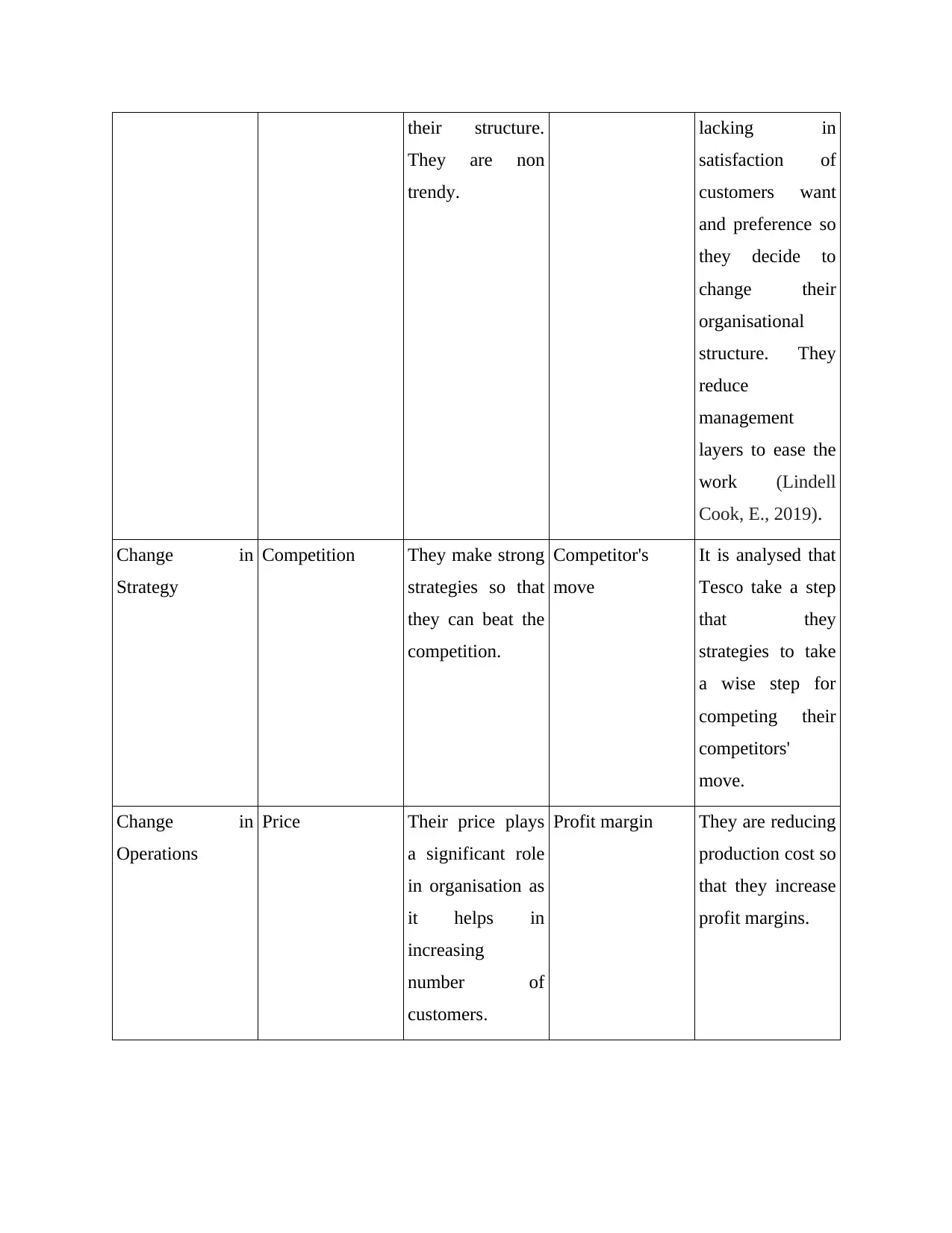
their structure.
They are non
trendy.
lacking in
satisfaction of
customers want
and preference so
they decide to
change their
organisational
structure. They
reduce
management
layers to ease the
work (Lindell
Cook, E., 2019).
Change in
Strategy
Competition They make strong
strategies so that
they can beat the
competition.
Competitor's
move
It is analysed that
Tesco take a step
that they
strategies to take
a wise step for
competing their
competitors'
move.
Change in
Operations
Price Their price plays
a significant role
in organisation as
it helps in
increasing
number of
customers.
Profit margin They are reducing
production cost so
that they increase
profit margins.
They are non
trendy.
lacking in
satisfaction of
customers want
and preference so
they decide to
change their
organisational
structure. They
reduce
management
layers to ease the
work (Lindell
Cook, E., 2019).
Change in
Strategy
Competition They make strong
strategies so that
they can beat the
competition.
Competitor's
move
It is analysed that
Tesco take a step
that they
strategies to take
a wise step for
competing their
competitors'
move.
Change in
Operations
Price Their price plays
a significant role
in organisation as
it helps in
increasing
number of
customers.
Profit margin They are reducing
production cost so
that they increase
profit margins.
⊘ This is a preview!⊘
Do you want full access?
Subscribe today to unlock all pages.

Trusted by 1+ million students worldwide
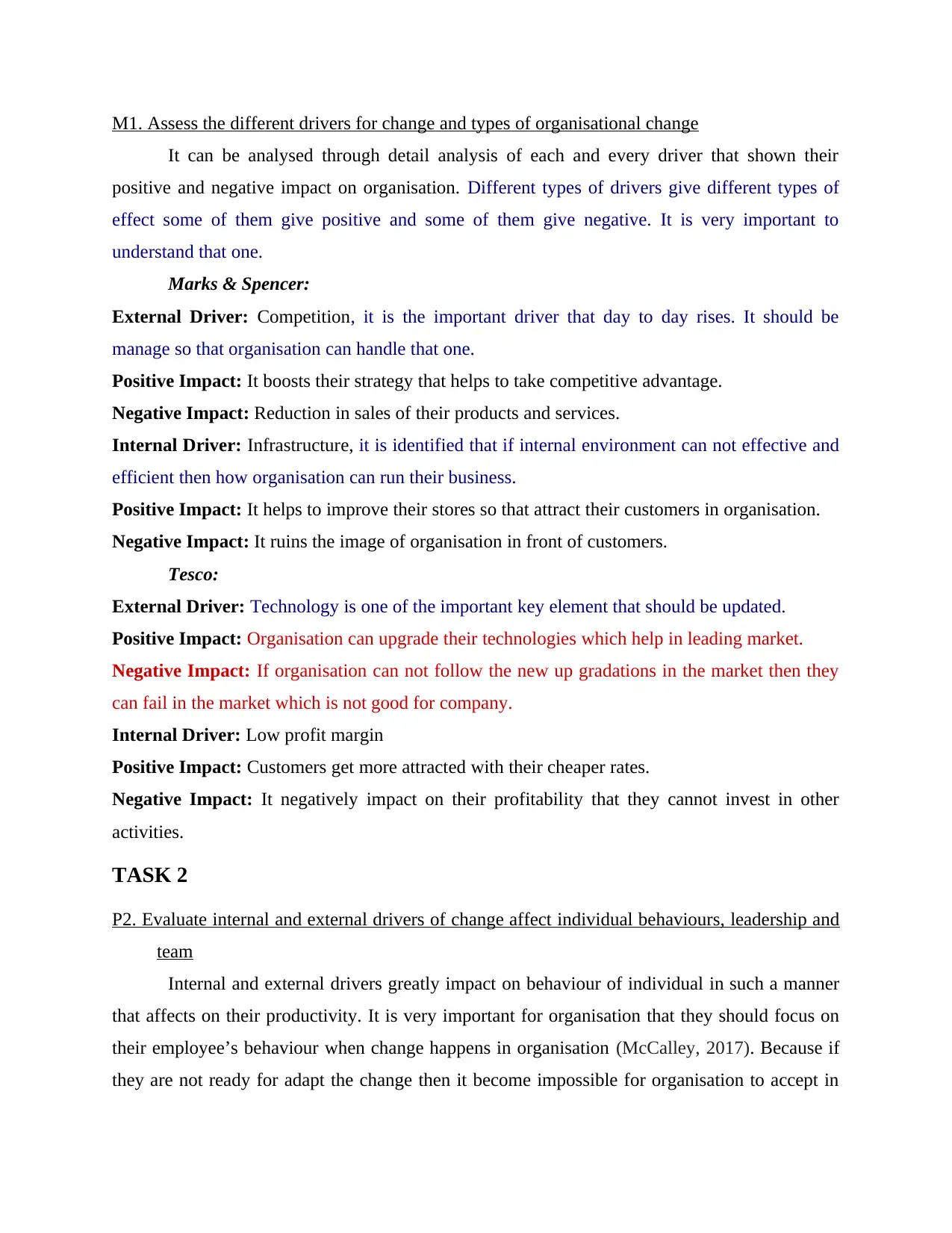
M1. Assess the different drivers for change and types of organisational change
It can be analysed through detail analysis of each and every driver that shown their
positive and negative impact on organisation. Different types of drivers give different types of
effect some of them give positive and some of them give negative. It is very important to
understand that one.
Marks & Spencer:
External Driver: Competition, it is the important driver that day to day rises. It should be
manage so that organisation can handle that one.
Positive Impact: It boosts their strategy that helps to take competitive advantage.
Negative Impact: Reduction in sales of their products and services.
Internal Driver: Infrastructure, it is identified that if internal environment can not effective and
efficient then how organisation can run their business.
Positive Impact: It helps to improve their stores so that attract their customers in organisation.
Negative Impact: It ruins the image of organisation in front of customers.
Tesco:
External Driver: Technology is one of the important key element that should be updated.
Positive Impact: Organisation can upgrade their technologies which help in leading market.
Negative Impact: If organisation can not follow the new up gradations in the market then they
can fail in the market which is not good for company.
Internal Driver: Low profit margin
Positive Impact: Customers get more attracted with their cheaper rates.
Negative Impact: It negatively impact on their profitability that they cannot invest in other
activities.
TASK 2
P2. Evaluate internal and external drivers of change affect individual behaviours, leadership and
team
Internal and external drivers greatly impact on behaviour of individual in such a manner
that affects on their productivity. It is very important for organisation that they should focus on
their employee’s behaviour when change happens in organisation (McCalley, 2017). Because if
they are not ready for adapt the change then it become impossible for organisation to accept in
It can be analysed through detail analysis of each and every driver that shown their
positive and negative impact on organisation. Different types of drivers give different types of
effect some of them give positive and some of them give negative. It is very important to
understand that one.
Marks & Spencer:
External Driver: Competition, it is the important driver that day to day rises. It should be
manage so that organisation can handle that one.
Positive Impact: It boosts their strategy that helps to take competitive advantage.
Negative Impact: Reduction in sales of their products and services.
Internal Driver: Infrastructure, it is identified that if internal environment can not effective and
efficient then how organisation can run their business.
Positive Impact: It helps to improve their stores so that attract their customers in organisation.
Negative Impact: It ruins the image of organisation in front of customers.
Tesco:
External Driver: Technology is one of the important key element that should be updated.
Positive Impact: Organisation can upgrade their technologies which help in leading market.
Negative Impact: If organisation can not follow the new up gradations in the market then they
can fail in the market which is not good for company.
Internal Driver: Low profit margin
Positive Impact: Customers get more attracted with their cheaper rates.
Negative Impact: It negatively impact on their profitability that they cannot invest in other
activities.
TASK 2
P2. Evaluate internal and external drivers of change affect individual behaviours, leadership and
team
Internal and external drivers greatly impact on behaviour of individual in such a manner
that affects on their productivity. It is very important for organisation that they should focus on
their employee’s behaviour when change happens in organisation (McCalley, 2017). Because if
they are not ready for adapt the change then it become impossible for organisation to accept in
Paraphrase This Document
Need a fresh take? Get an instant paraphrase of this document with our AI Paraphraser
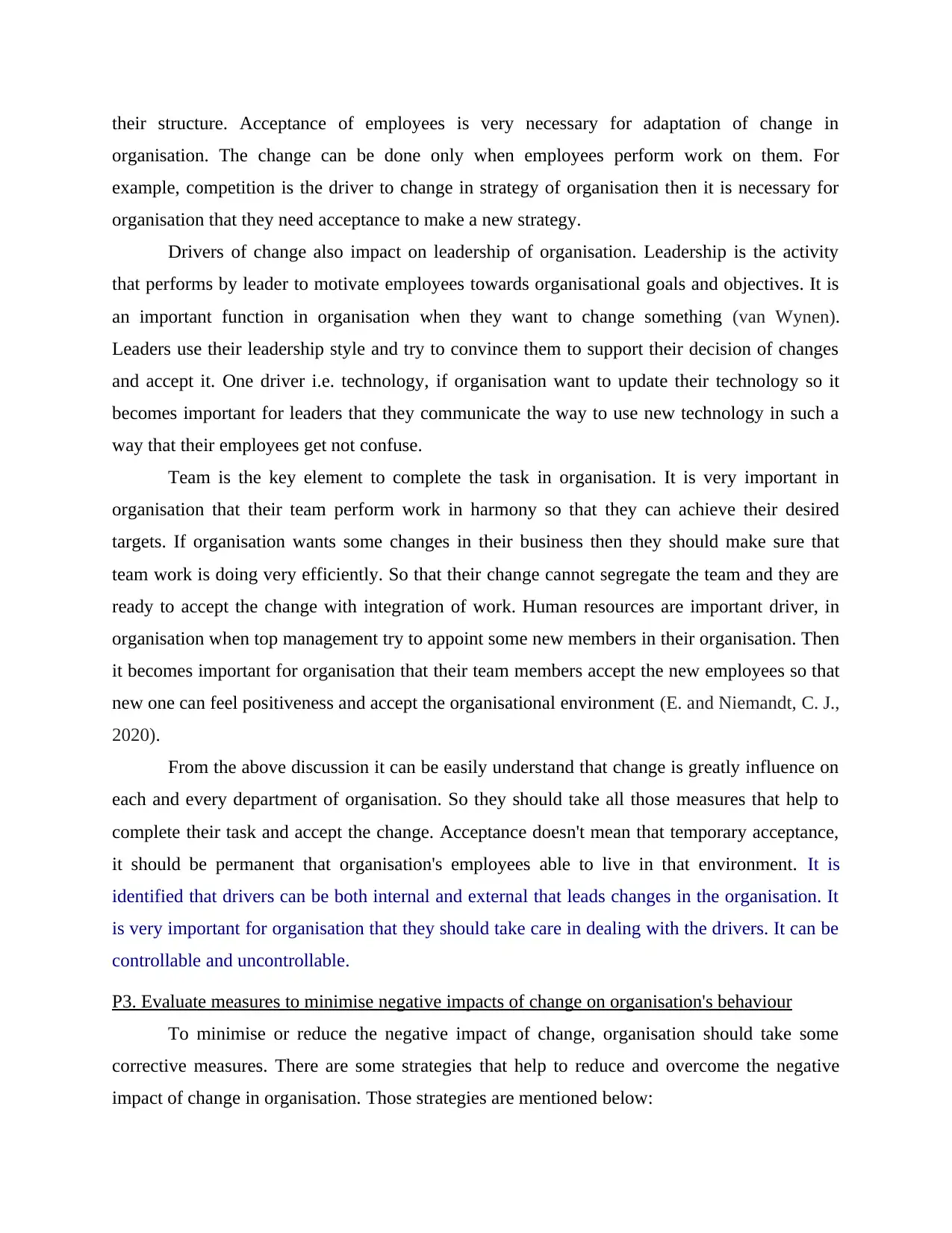
their structure. Acceptance of employees is very necessary for adaptation of change in
organisation. The change can be done only when employees perform work on them. For
example, competition is the driver to change in strategy of organisation then it is necessary for
organisation that they need acceptance to make a new strategy.
Drivers of change also impact on leadership of organisation. Leadership is the activity
that performs by leader to motivate employees towards organisational goals and objectives. It is
an important function in organisation when they want to change something (van Wynen).
Leaders use their leadership style and try to convince them to support their decision of changes
and accept it. One driver i.e. technology, if organisation want to update their technology so it
becomes important for leaders that they communicate the way to use new technology in such a
way that their employees get not confuse.
Team is the key element to complete the task in organisation. It is very important in
organisation that their team perform work in harmony so that they can achieve their desired
targets. If organisation wants some changes in their business then they should make sure that
team work is doing very efficiently. So that their change cannot segregate the team and they are
ready to accept the change with integration of work. Human resources are important driver, in
organisation when top management try to appoint some new members in their organisation. Then
it becomes important for organisation that their team members accept the new employees so that
new one can feel positiveness and accept the organisational environment (E. and Niemandt, C. J.,
2020).
From the above discussion it can be easily understand that change is greatly influence on
each and every department of organisation. So they should take all those measures that help to
complete their task and accept the change. Acceptance doesn't mean that temporary acceptance,
it should be permanent that organisation's employees able to live in that environment. It is
identified that drivers can be both internal and external that leads changes in the organisation. It
is very important for organisation that they should take care in dealing with the drivers. It can be
controllable and uncontrollable.
P3. Evaluate measures to minimise negative impacts of change on organisation's behaviour
To minimise or reduce the negative impact of change, organisation should take some
corrective measures. There are some strategies that help to reduce and overcome the negative
impact of change in organisation. Those strategies are mentioned below:
organisation. The change can be done only when employees perform work on them. For
example, competition is the driver to change in strategy of organisation then it is necessary for
organisation that they need acceptance to make a new strategy.
Drivers of change also impact on leadership of organisation. Leadership is the activity
that performs by leader to motivate employees towards organisational goals and objectives. It is
an important function in organisation when they want to change something (van Wynen).
Leaders use their leadership style and try to convince them to support their decision of changes
and accept it. One driver i.e. technology, if organisation want to update their technology so it
becomes important for leaders that they communicate the way to use new technology in such a
way that their employees get not confuse.
Team is the key element to complete the task in organisation. It is very important in
organisation that their team perform work in harmony so that they can achieve their desired
targets. If organisation wants some changes in their business then they should make sure that
team work is doing very efficiently. So that their change cannot segregate the team and they are
ready to accept the change with integration of work. Human resources are important driver, in
organisation when top management try to appoint some new members in their organisation. Then
it becomes important for organisation that their team members accept the new employees so that
new one can feel positiveness and accept the organisational environment (E. and Niemandt, C. J.,
2020).
From the above discussion it can be easily understand that change is greatly influence on
each and every department of organisation. So they should take all those measures that help to
complete their task and accept the change. Acceptance doesn't mean that temporary acceptance,
it should be permanent that organisation's employees able to live in that environment. It is
identified that drivers can be both internal and external that leads changes in the organisation. It
is very important for organisation that they should take care in dealing with the drivers. It can be
controllable and uncontrollable.
P3. Evaluate measures to minimise negative impacts of change on organisation's behaviour
To minimise or reduce the negative impact of change, organisation should take some
corrective measures. There are some strategies that help to reduce and overcome the negative
impact of change in organisation. Those strategies are mentioned below:
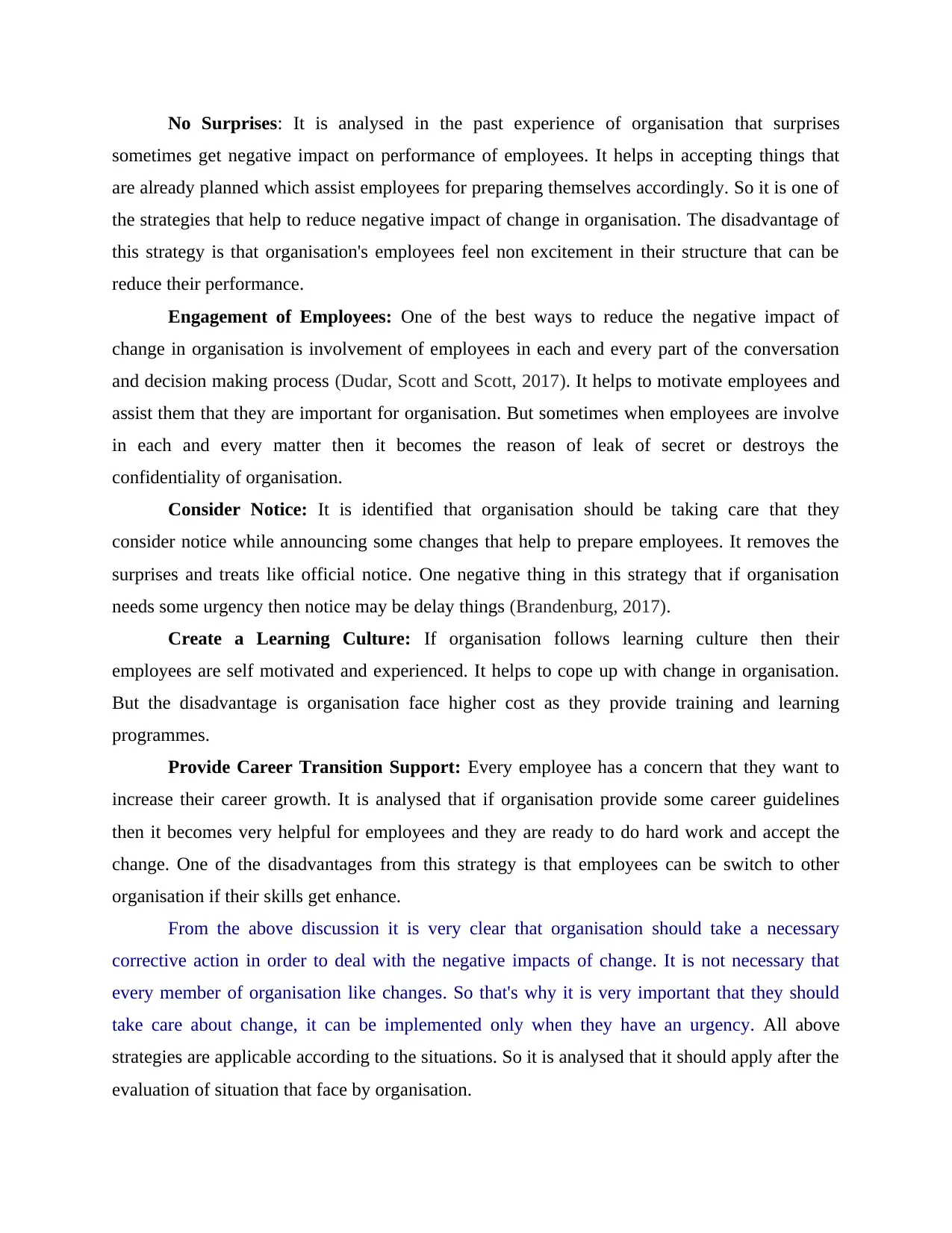
No Surprises: It is analysed in the past experience of organisation that surprises
sometimes get negative impact on performance of employees. It helps in accepting things that
are already planned which assist employees for preparing themselves accordingly. So it is one of
the strategies that help to reduce negative impact of change in organisation. The disadvantage of
this strategy is that organisation's employees feel non excitement in their structure that can be
reduce their performance.
Engagement of Employees: One of the best ways to reduce the negative impact of
change in organisation is involvement of employees in each and every part of the conversation
and decision making process (Dudar, Scott and Scott, 2017). It helps to motivate employees and
assist them that they are important for organisation. But sometimes when employees are involve
in each and every matter then it becomes the reason of leak of secret or destroys the
confidentiality of organisation.
Consider Notice: It is identified that organisation should be taking care that they
consider notice while announcing some changes that help to prepare employees. It removes the
surprises and treats like official notice. One negative thing in this strategy that if organisation
needs some urgency then notice may be delay things (Brandenburg, 2017).
Create a Learning Culture: If organisation follows learning culture then their
employees are self motivated and experienced. It helps to cope up with change in organisation.
But the disadvantage is organisation face higher cost as they provide training and learning
programmes.
Provide Career Transition Support: Every employee has a concern that they want to
increase their career growth. It is analysed that if organisation provide some career guidelines
then it becomes very helpful for employees and they are ready to do hard work and accept the
change. One of the disadvantages from this strategy is that employees can be switch to other
organisation if their skills get enhance.
From the above discussion it is very clear that organisation should take a necessary
corrective action in order to deal with the negative impacts of change. It is not necessary that
every member of organisation like changes. So that's why it is very important that they should
take care about change, it can be implemented only when they have an urgency. All above
strategies are applicable according to the situations. So it is analysed that it should apply after the
evaluation of situation that face by organisation.
sometimes get negative impact on performance of employees. It helps in accepting things that
are already planned which assist employees for preparing themselves accordingly. So it is one of
the strategies that help to reduce negative impact of change in organisation. The disadvantage of
this strategy is that organisation's employees feel non excitement in their structure that can be
reduce their performance.
Engagement of Employees: One of the best ways to reduce the negative impact of
change in organisation is involvement of employees in each and every part of the conversation
and decision making process (Dudar, Scott and Scott, 2017). It helps to motivate employees and
assist them that they are important for organisation. But sometimes when employees are involve
in each and every matter then it becomes the reason of leak of secret or destroys the
confidentiality of organisation.
Consider Notice: It is identified that organisation should be taking care that they
consider notice while announcing some changes that help to prepare employees. It removes the
surprises and treats like official notice. One negative thing in this strategy that if organisation
needs some urgency then notice may be delay things (Brandenburg, 2017).
Create a Learning Culture: If organisation follows learning culture then their
employees are self motivated and experienced. It helps to cope up with change in organisation.
But the disadvantage is organisation face higher cost as they provide training and learning
programmes.
Provide Career Transition Support: Every employee has a concern that they want to
increase their career growth. It is analysed that if organisation provide some career guidelines
then it becomes very helpful for employees and they are ready to do hard work and accept the
change. One of the disadvantages from this strategy is that employees can be switch to other
organisation if their skills get enhance.
From the above discussion it is very clear that organisation should take a necessary
corrective action in order to deal with the negative impacts of change. It is not necessary that
every member of organisation like changes. So that's why it is very important that they should
take care about change, it can be implemented only when they have an urgency. All above
strategies are applicable according to the situations. So it is analysed that it should apply after the
evaluation of situation that face by organisation.
⊘ This is a preview!⊘
Do you want full access?
Subscribe today to unlock all pages.

Trusted by 1+ million students worldwide
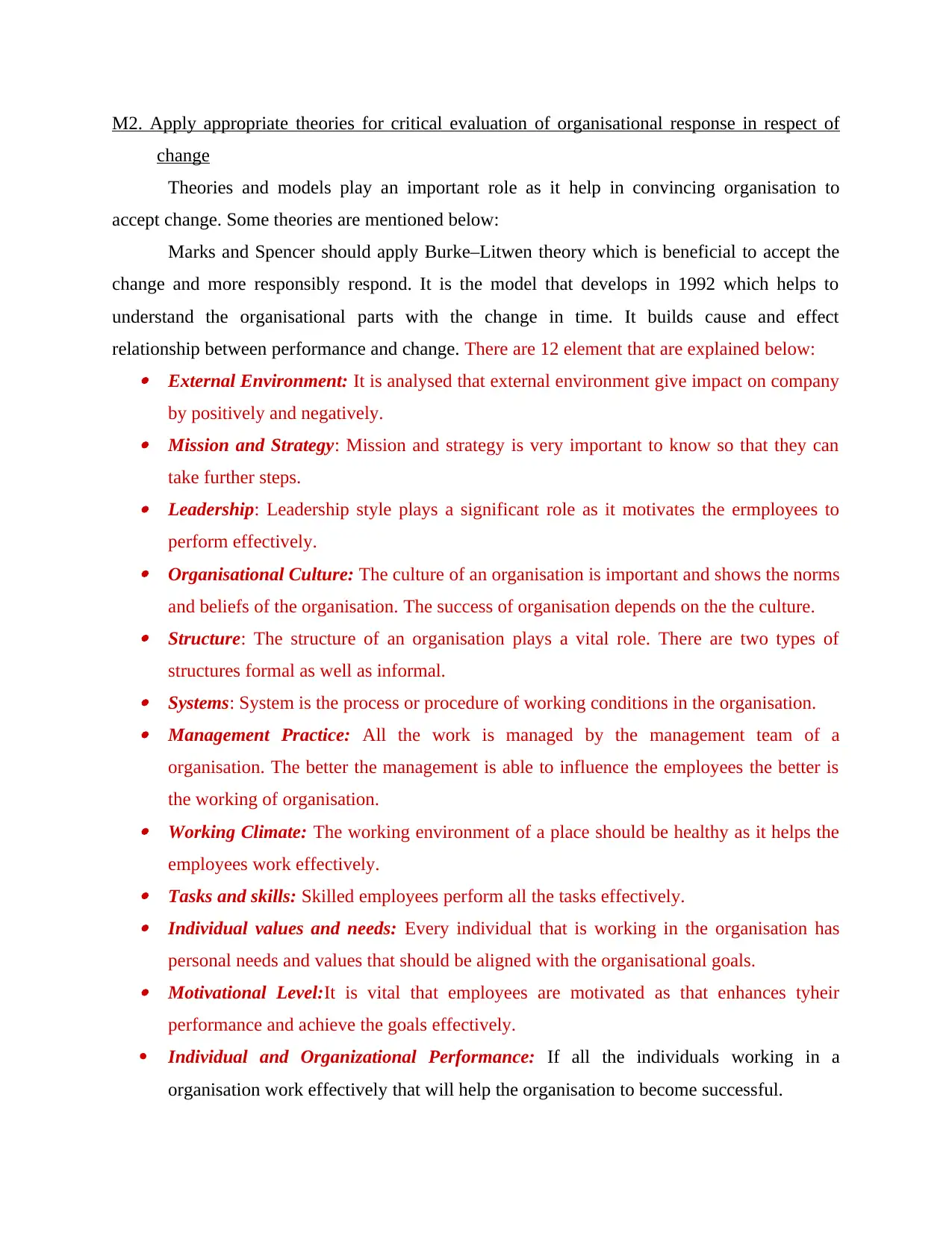
M2. Apply appropriate theories for critical evaluation of organisational response in respect of
change
Theories and models play an important role as it help in convincing organisation to
accept change. Some theories are mentioned below:
Marks and Spencer should apply Burke–Litwen theory which is beneficial to accept the
change and more responsibly respond. It is the model that develops in 1992 which helps to
understand the organisational parts with the change in time. It builds cause and effect
relationship between performance and change. There are 12 element that are explained below: External Environment: It is analysed that external environment give impact on company
by positively and negatively. Mission and Strategy: Mission and strategy is very important to know so that they can
take further steps. Leadership: Leadership style plays a significant role as it motivates the ermployees to
perform effectively. Organisational Culture: The culture of an organisation is important and shows the norms
and beliefs of the organisation. The success of organisation depends on the the culture. Structure: The structure of an organisation plays a vital role. There are two types of
structures formal as well as informal. Systems: System is the process or procedure of working conditions in the organisation. Management Practice: All the work is managed by the management team of a
organisation. The better the management is able to influence the employees the better is
the working of organisation. Working Climate: The working environment of a place should be healthy as it helps the
employees work effectively. Tasks and skills: Skilled employees perform all the tasks effectively. Individual values and needs: Every individual that is working in the organisation has
personal needs and values that should be aligned with the organisational goals. Motivational Level:It is vital that employees are motivated as that enhances tyheir
performance and achieve the goals effectively.
Individual and Organizational Performance: If all the individuals working in a
organisation work effectively that will help the organisation to become successful.
change
Theories and models play an important role as it help in convincing organisation to
accept change. Some theories are mentioned below:
Marks and Spencer should apply Burke–Litwen theory which is beneficial to accept the
change and more responsibly respond. It is the model that develops in 1992 which helps to
understand the organisational parts with the change in time. It builds cause and effect
relationship between performance and change. There are 12 element that are explained below: External Environment: It is analysed that external environment give impact on company
by positively and negatively. Mission and Strategy: Mission and strategy is very important to know so that they can
take further steps. Leadership: Leadership style plays a significant role as it motivates the ermployees to
perform effectively. Organisational Culture: The culture of an organisation is important and shows the norms
and beliefs of the organisation. The success of organisation depends on the the culture. Structure: The structure of an organisation plays a vital role. There are two types of
structures formal as well as informal. Systems: System is the process or procedure of working conditions in the organisation. Management Practice: All the work is managed by the management team of a
organisation. The better the management is able to influence the employees the better is
the working of organisation. Working Climate: The working environment of a place should be healthy as it helps the
employees work effectively. Tasks and skills: Skilled employees perform all the tasks effectively. Individual values and needs: Every individual that is working in the organisation has
personal needs and values that should be aligned with the organisational goals. Motivational Level:It is vital that employees are motivated as that enhances tyheir
performance and achieve the goals effectively.
Individual and Organizational Performance: If all the individuals working in a
organisation work effectively that will help the organisation to become successful.
Paraphrase This Document
Need a fresh take? Get an instant paraphrase of this document with our AI Paraphraser
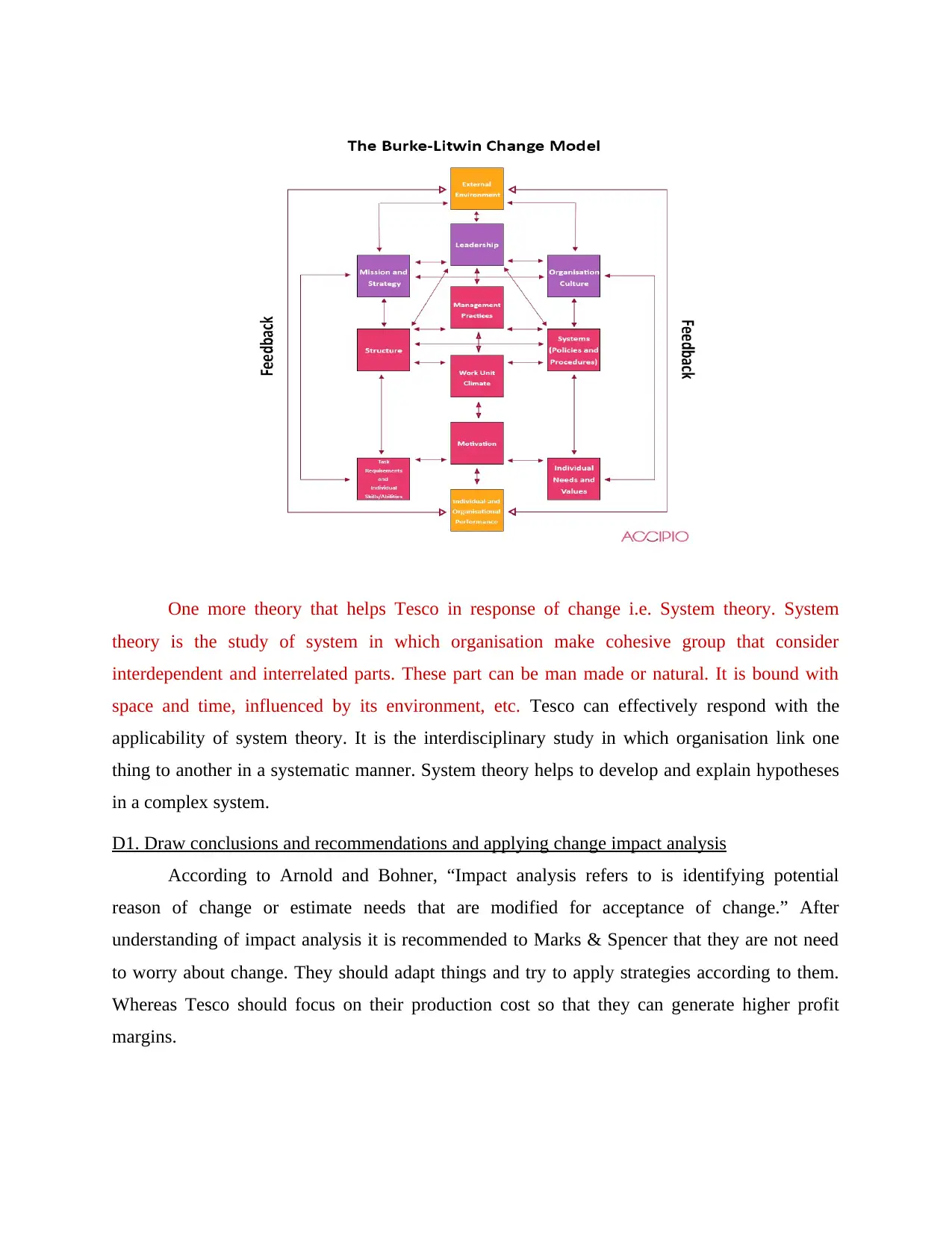
One more theory that helps Tesco in response of change i.e. System theory. System
theory is the study of system in which organisation make cohesive group that consider
interdependent and interrelated parts. These part can be man made or natural. It is bound with
space and time, influenced by its environment, etc. Tesco can effectively respond with the
applicability of system theory. It is the interdisciplinary study in which organisation link one
thing to another in a systematic manner. System theory helps to develop and explain hypotheses
in a complex system.
D1. Draw conclusions and recommendations and applying change impact analysis
According to Arnold and Bohner, “Impact analysis refers to is identifying potential
reason of change or estimate needs that are modified for acceptance of change.” After
understanding of impact analysis it is recommended to Marks & Spencer that they are not need
to worry about change. They should adapt things and try to apply strategies according to them.
Whereas Tesco should focus on their production cost so that they can generate higher profit
margins.
theory is the study of system in which organisation make cohesive group that consider
interdependent and interrelated parts. These part can be man made or natural. It is bound with
space and time, influenced by its environment, etc. Tesco can effectively respond with the
applicability of system theory. It is the interdisciplinary study in which organisation link one
thing to another in a systematic manner. System theory helps to develop and explain hypotheses
in a complex system.
D1. Draw conclusions and recommendations and applying change impact analysis
According to Arnold and Bohner, “Impact analysis refers to is identifying potential
reason of change or estimate needs that are modified for acceptance of change.” After
understanding of impact analysis it is recommended to Marks & Spencer that they are not need
to worry about change. They should adapt things and try to apply strategies according to them.
Whereas Tesco should focus on their production cost so that they can generate higher profit
margins.
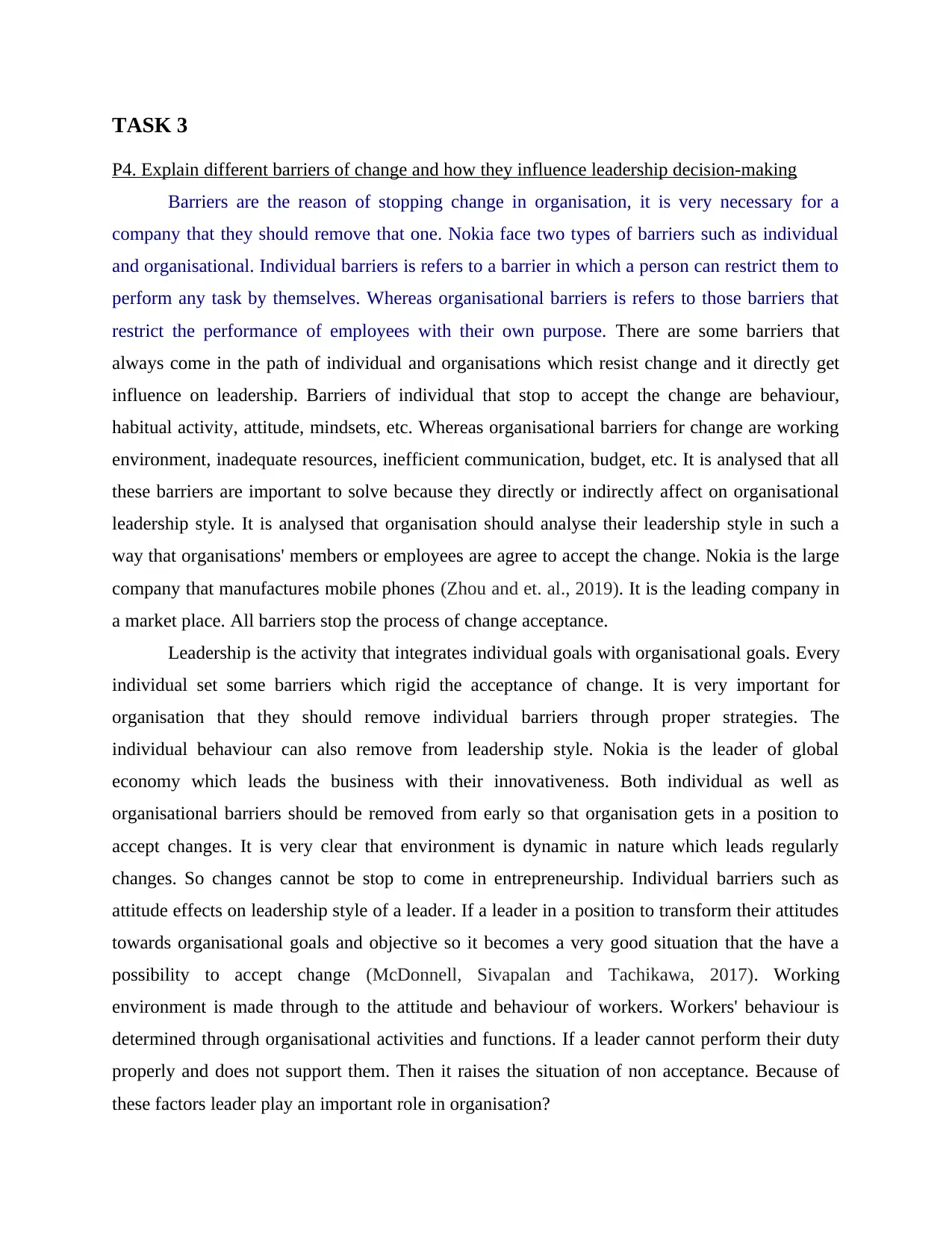
TASK 3
P4. Explain different barriers of change and how they influence leadership decision-making
Barriers are the reason of stopping change in organisation, it is very necessary for a
company that they should remove that one. Nokia face two types of barriers such as individual
and organisational. Individual barriers is refers to a barrier in which a person can restrict them to
perform any task by themselves. Whereas organisational barriers is refers to those barriers that
restrict the performance of employees with their own purpose. There are some barriers that
always come in the path of individual and organisations which resist change and it directly get
influence on leadership. Barriers of individual that stop to accept the change are behaviour,
habitual activity, attitude, mindsets, etc. Whereas organisational barriers for change are working
environment, inadequate resources, inefficient communication, budget, etc. It is analysed that all
these barriers are important to solve because they directly or indirectly affect on organisational
leadership style. It is analysed that organisation should analyse their leadership style in such a
way that organisations' members or employees are agree to accept the change. Nokia is the large
company that manufactures mobile phones (Zhou and et. al., 2019). It is the leading company in
a market place. All barriers stop the process of change acceptance.
Leadership is the activity that integrates individual goals with organisational goals. Every
individual set some barriers which rigid the acceptance of change. It is very important for
organisation that they should remove individual barriers through proper strategies. The
individual behaviour can also remove from leadership style. Nokia is the leader of global
economy which leads the business with their innovativeness. Both individual as well as
organisational barriers should be removed from early so that organisation gets in a position to
accept changes. It is very clear that environment is dynamic in nature which leads regularly
changes. So changes cannot be stop to come in entrepreneurship. Individual barriers such as
attitude effects on leadership style of a leader. If a leader in a position to transform their attitudes
towards organisational goals and objective so it becomes a very good situation that the have a
possibility to accept change (McDonnell, Sivapalan and Tachikawa, 2017). Working
environment is made through to the attitude and behaviour of workers. Workers' behaviour is
determined through organisational activities and functions. If a leader cannot perform their duty
properly and does not support them. Then it raises the situation of non acceptance. Because of
these factors leader play an important role in organisation?
P4. Explain different barriers of change and how they influence leadership decision-making
Barriers are the reason of stopping change in organisation, it is very necessary for a
company that they should remove that one. Nokia face two types of barriers such as individual
and organisational. Individual barriers is refers to a barrier in which a person can restrict them to
perform any task by themselves. Whereas organisational barriers is refers to those barriers that
restrict the performance of employees with their own purpose. There are some barriers that
always come in the path of individual and organisations which resist change and it directly get
influence on leadership. Barriers of individual that stop to accept the change are behaviour,
habitual activity, attitude, mindsets, etc. Whereas organisational barriers for change are working
environment, inadequate resources, inefficient communication, budget, etc. It is analysed that all
these barriers are important to solve because they directly or indirectly affect on organisational
leadership style. It is analysed that organisation should analyse their leadership style in such a
way that organisations' members or employees are agree to accept the change. Nokia is the large
company that manufactures mobile phones (Zhou and et. al., 2019). It is the leading company in
a market place. All barriers stop the process of change acceptance.
Leadership is the activity that integrates individual goals with organisational goals. Every
individual set some barriers which rigid the acceptance of change. It is very important for
organisation that they should remove individual barriers through proper strategies. The
individual behaviour can also remove from leadership style. Nokia is the leader of global
economy which leads the business with their innovativeness. Both individual as well as
organisational barriers should be removed from early so that organisation gets in a position to
accept changes. It is very clear that environment is dynamic in nature which leads regularly
changes. So changes cannot be stop to come in entrepreneurship. Individual barriers such as
attitude effects on leadership style of a leader. If a leader in a position to transform their attitudes
towards organisational goals and objective so it becomes a very good situation that the have a
possibility to accept change (McDonnell, Sivapalan and Tachikawa, 2017). Working
environment is made through to the attitude and behaviour of workers. Workers' behaviour is
determined through organisational activities and functions. If a leader cannot perform their duty
properly and does not support them. Then it raises the situation of non acceptance. Because of
these factors leader play an important role in organisation?
⊘ This is a preview!⊘
Do you want full access?
Subscribe today to unlock all pages.

Trusted by 1+ million students worldwide
1 out of 20
Related Documents
Your All-in-One AI-Powered Toolkit for Academic Success.
+13062052269
info@desklib.com
Available 24*7 on WhatsApp / Email
![[object Object]](/_next/static/media/star-bottom.7253800d.svg)
Unlock your academic potential
Copyright © 2020–2025 A2Z Services. All Rights Reserved. Developed and managed by ZUCOL.





